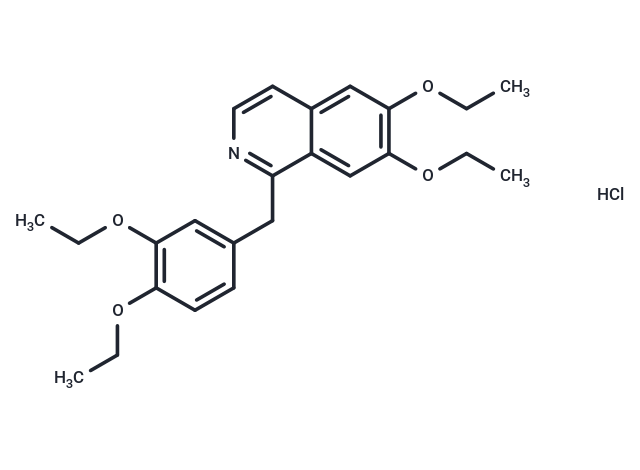Shopping Cart
- Remove All
 Your shopping cart is currently empty
Your shopping cart is currently empty

Ethaverine hydrochloride is a homologue of papaverine and is used as a vasodilator and antispasmodic.[2]

| Pack Size | Price | Availability | Quantity |
|---|---|---|---|
| 1 mg | $30 | In Stock | |
| 2 mg | $39 | In Stock | |
| 5 mg | $60 | In Stock | |
| 10 mg | $109 | In Stock | |
| 25 mg | $202 | In Stock | |
| 50 mg | $360 | In Stock | |
| 100 mg | $568 | In Stock | |
| 500 mg | $1,230 | In Stock | |
| 1 mL x 10 mM (in DMSO) | $98 | In Stock |
| Description | Ethaverine hydrochloride is a homologue of papaverine and is used as a vasodilator and antispasmodic.[2] |
| In vitro | METHODS: The inhibitory effect of ethaverine on dopamine content in PC12 cells was studied. RESULTS Ethaverine reduced dopamine content in PC12 cells in a concentration-dependent manner. At a concentration of 1.0 μM, dopamine content was inhibited by 33.6% within 24-48 hours. The IC50 value of ethaverine was 1.4 μM. 2.0 μM ethaverine reduced dopamine content after 6 hours of action. Tyrosine hydroxylase (TH) was inhibited after 6 hours of ethaverine treatment in PC12 cells, and the activity remained at a reduced level until 36 hours (the inhibition rate was 12-22% at 2.0 μM). [1] Ethaverine (10 μM) treatment in PC12 cells reduces catecholamine secretion by blocking L-type voltage-sensitive Ca2+ channels. [2] |
| In vivo | METHODS: In a short-term experiment on 11 guinea pigs, the effect of Ethaverine hydrochloride on cochlear microcirculation was observed (2/5 and /10 mg/kg, i.v) for 10 minutes. In these experiments, intracochlear PO2, intracochlear potential (EP), cochlear microphonic (CM) potential, and blood pressure (BP) were recorded. Intracochlear PO2 was measured polarographically in the mid-level using gold electrodes. RESULTS Ethaverine hydrochloride at doses of 5 and 10 mg/kg caused a significant increase in intracochlear PO2 for 35 to 90 minutes, even with a temporary decrease in blood pressure. At the same time, this improvement in cochlear microcirculation was observed to coincide with an increase in CM potential. The decrease in EP may be the result of a decrease in blood pressure and a direct effect of Ethaverine hydrochloride on EP production. [3] |
| Alias | Papetherine, Ethaquin, Consenil |
| Molecular Weight | 431.96 |
| Formula | C24H30ClNO4 |
| Cas No. | 985-13-7 |
| Smiles | CCOc1c(OCC)cc(Cc2nccc3cc(OCC)c(OCC)cc23)cc1.Cl |
| Relative Density. | 1.104g/cm3 |
| Storage | Powder: -20°C for 3 years | In solvent: -80°C for 1 year | Shipping with blue ice. | |||||||||||||||||||||||||||||||||||
| Solubility Information | H2O: 100 mg/mL (231.5 mM), Sonication is recommended. DMSO: 45 mg/mL (104.18 mM), Sonication is recommended. | |||||||||||||||||||||||||||||||||||
Solution Preparation Table | ||||||||||||||||||||||||||||||||||||
DMSO/H2O
| ||||||||||||||||||||||||||||||||||||

Copyright © 2015-2025 TargetMol Chemicals Inc. All Rights Reserved.